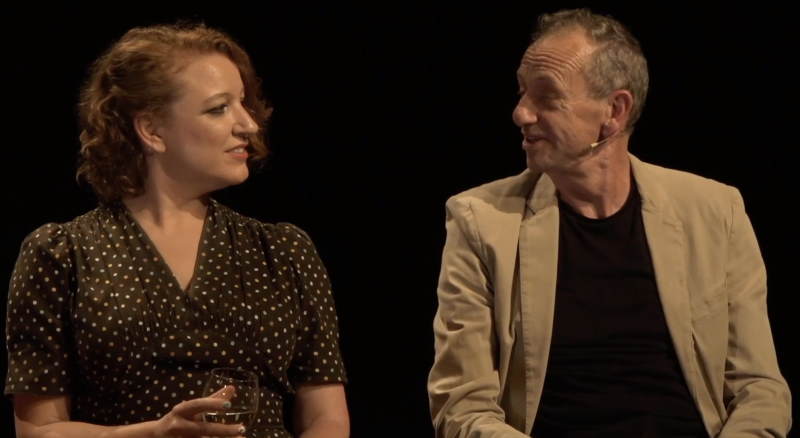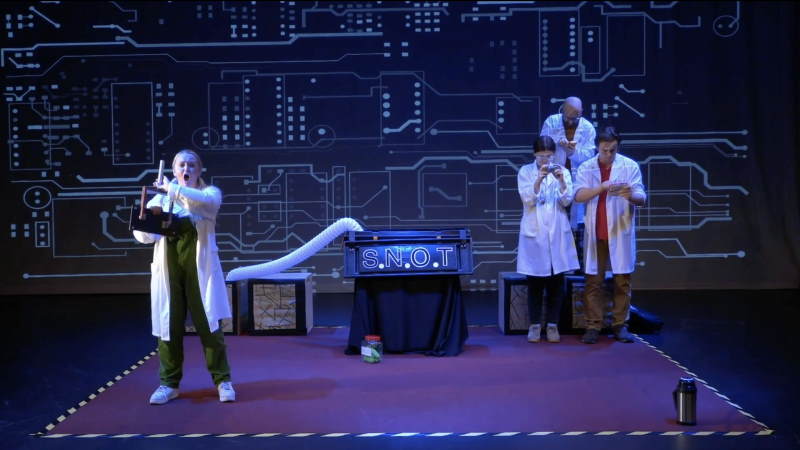AMATA deploys Sennheiser Digital 6000 at Edinburgh Festival Fringe 2021 Digital Showcase

This August, AMATA, a vibrant performing arts hub within Falmouth University, partnered with the Pleasance Theatre Trust to become a satellite venue for the Edinburgh Fringe, presenting a digital showcase as part of Pleasance’s Edinburgh programme. Emulating the success of live streams done by the National Theatre and the Royal Opera House, AMATA transformed their largest studio into a partial TV studio format so that the shows could not only be performed live, but also live-streamed at the same time. As the sound aspect of each performance had to double up as both show sound and broadcast sound, Sennheiser Digital 6000 was chosen as the perfect solution to these diverse requirements due to the system’s “incredibly quick setup time, ease of use, the ability to program the transmitters on the fly and, most important of all, its really clean sound”.
“AMATA‘s initial live-streamed performances took place in the 2021 spring season and we wanted to build on that success. As the plans for the Edinburgh Fringe were being developed, it was clear that live streaming was going to be a big part of their 2021 offer,” says Collin Chivers, Director of Broadcast Ed festival AMATA, Falmouth University. “AMATA approached the Pleasance Theatre Trust, who had also been developing live-streamed shows during the pandemic, and the Edinburgh Fringe Digital Showcase was born.”
With financial support from Arts Council England, this enabled AMATA to work with six companies, three Cornwall based, and three non-Cornwall based, to develop their work for online audiences. Having had experience working on a digital performance programme in autumn 2020 and spring 2021, live-streaming theatre and music performances from the AMATA studios, the team was ideally positioned to deliver both live and digital elements of this year’s diverse festival programme. “In fact, our Technical Producer has worked on the live-streams for the National Theatre, and the Director of Broadcast has also worked on the live-streams for the Royal Opera House. Both now live in Cornwall and work for Falmouth University and AMATA,” adds Chivers.
One show was held each week in the first two weeks, followed by two shows per week for the remaining two weeks over the entire one month of the festival. “This was because, as part of the scope of the project, we invited companies that had never been involved in a live-streaming event before,” explains Chivers. “So, it involved a lot of rehearsals for the productions in order to adapt the shows to a live-streaming format whilst maintaining the ‘live’ stage essence of the show, given that they were performed in front of a socially distanced audience of around 26 people, chosen from a large number of applicants by a ticket raffle.”
From a technical perspective, on average the team had six cameras involved with each production as well as the sound, video and lighting required for each show. “The lighting, video mixing and sound control were all done in front of the audience, which made for an incredibly interesting and interactive environment for audience and performers,” Chivers reminisces.

Picture: James Scarle
As the sound element had to serve both as the show sound and the broadcast sound, the team had to choose a system that would be highly versatile and be able to cope with specs that had to be changed repeatedly, depending on each show. Additionally, at the end of each performance there was a Q&A session with the actors and directors involving both live and online audiences across different platforms.
“This required an incredibly quick changeover of sound from that of the show. Sennheiser’s D6000 system was the perfect solution to these diverse requirements with its incredibly quick setup time, ease of use, the ability to program the transmitters on the fly and, most important of all, its really clean sound. We had several remarks from the audience, both live and online, of how good the sound was, with the D6000 system allowing us to maintain exceptional sound quality over the entire spectrum of performances,” says Chivers.

L-R: Kirsty Newton, Arthur Smith. Picture: Daniel Ledley
Speaking of the support received from Kevin Gwyther-Brown, Business Development Manager, Sennheiser, Chivers notes how incredibly important it was to be able to receive direct guidance from a industry-leading audio specialist like Sennheiser, especially in a university where the student contact and learning experience can be very beneficial for both the company and student.
“From the first time I called Kevin about our project and the possibility of Sennheiser being involved, he and the guys at Sennheiser have been fantastic and incredibly supportive. We were not sure at first if the D6000 system was the correct system for us, as we thought that we may need a larger number of channels and mic swapping to overcome some of the inherent problems that we faced. But after speaking with Kevin, we were convinced it would work for us, and he even took the time to do an ad-hoc training session with our second-year technical students over the course of the day, which they really enjoyed!” Chivers notes.
The timing of the shows could not have been better for the students, according to Chivers. AMATA runs a two-year accelerated (Hon) degree in Technical Theatre Arts, which means that it is also taught in the summer months, so the students were available to participate in the project. Other students came from the School of Film and Television (SOFT), which offered a unique experience of mixing groups of students from different environments and giving them first-hand experience of the differences between the two art forms, “and not just in light of the technology, but also of performance art,” says Chivers.

Picture: Josh Hooker
“Live-streaming of theatre is not just about following a performance, nor is it about a performance for film. It is a collaboration of two art forms which brings a unique perspective of interactivity between live and on-line audiences, each one seeing a different point of view. When directed with this in mind, it can produce a new vibrant art form that I hope the theatre industry will continue to explore and expand,” says Chivers. According to Chivers, the students who were involved in these projects will find themselves well equipped to work in such a collaborative environment in the future, offering them with the potential to be part of developing this genre and leading theatre into a new, worldwide performance art.
“I am very proud of the team of technicians and students that took part and worked in an incredibly professional manner throughout the showcase. Without such a great team of committed and passionate individuals we would simply not be able to execute the project to such a high standard,” he adds.
And how instrumental was Digital 6000 in the overall success of the Digital Showcase at Edinburgh Festival Fringe 2021? Chivers leaves no room for doubt on that.
“Quite simply it meant everything; from making changeovers faster and simpler to reducing the number of channels and increasing the production values, exceeding expectations in the quality of the sound,” Chivers concludes. “I know the D6000 systems are very popular and now I see why. Without such a system during this project we would have not had time for our coffee in the morning!”
 How to resolve AdBlock issue?
How to resolve AdBlock issue?